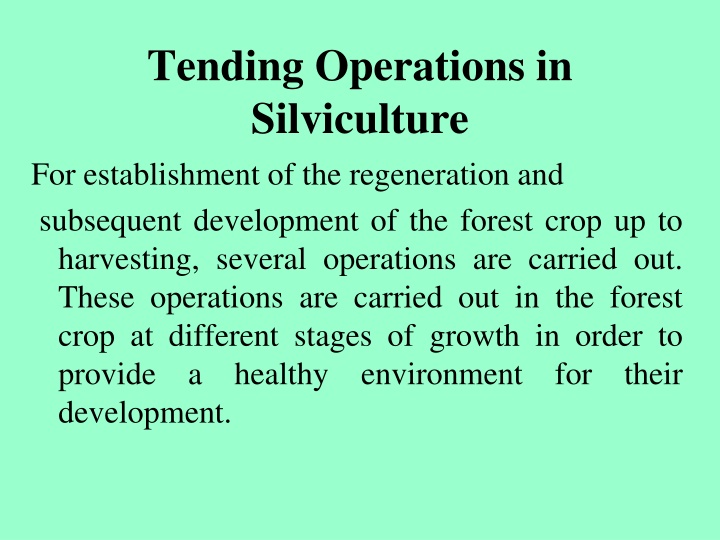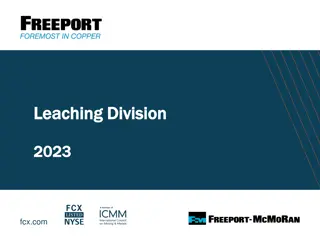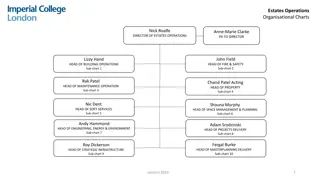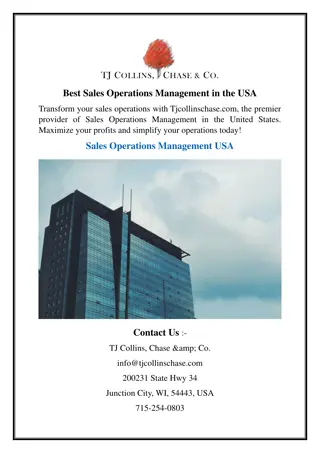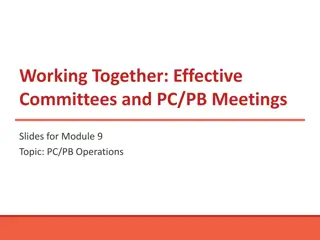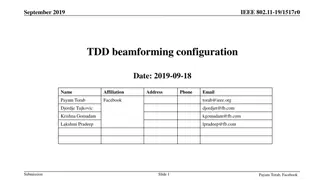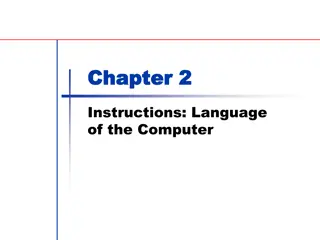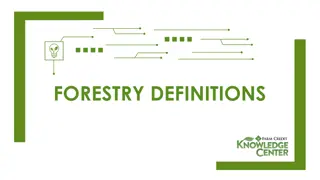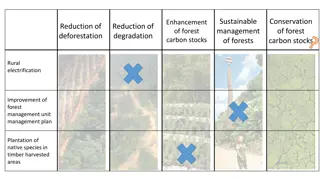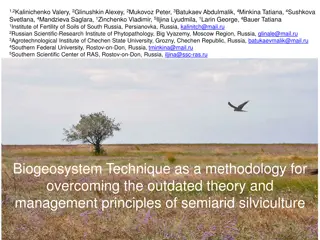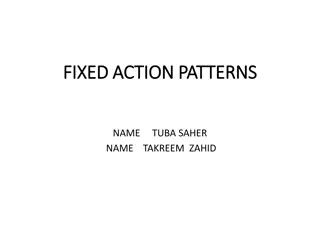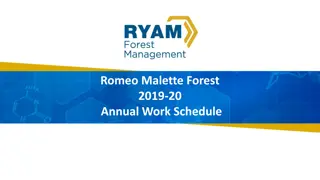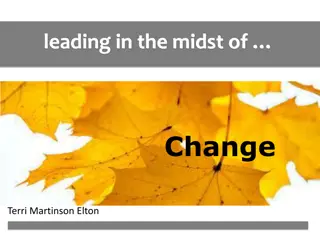Tending Operations in Silviculture: A Comprehensive Guide
Tending operations in silviculture are crucial for the establishment and development of forest crops. These operations include weeding, cleaning, thinning, improvement felling, pruning, and climber cutting. Each operation serves a specific purpose in ensuring the healthy growth and development of the forest. Thinning, in particular, plays a vital role in improving hygiene, salvaging merchantable volume, maintaining physical growth conditions, and obtaining the desired crop structure. By understanding and implementing these tending operations, foresters can enhance the overall health and productivity of forest ecosystems.
Download Presentation

Please find below an Image/Link to download the presentation.
The content on the website is provided AS IS for your information and personal use only. It may not be sold, licensed, or shared on other websites without obtaining consent from the author.If you encounter any issues during the download, it is possible that the publisher has removed the file from their server.
You are allowed to download the files provided on this website for personal or commercial use, subject to the condition that they are used lawfully. All files are the property of their respective owners.
The content on the website is provided AS IS for your information and personal use only. It may not be sold, licensed, or shared on other websites without obtaining consent from the author.
E N D
Presentation Transcript
Tending Operations in Silviculture For establishment of the regeneration and subsequent development of the forest crop up to harvesting, several operations are carried out. These operations are carried out in the forest crop at different stages of growth in order to provide a healthy development. environment for their
These operations are called tending operations includes: i) Weeding ii) Cleaning iii) Thinning, iv) Improvement Felling, v) Pruning vi) Climber Cutting
i) Weeding: Weeds may be controlled by following methods: a) Mechanical Methods b) Biological Methods c) Chemical Methods ii) Cleaning: Cleaning is carried out in a crop which has not crossed the sapling stage and is defined as the cutting made in order to face the best individuals from undesirable one of the same age which interfere or are likely to interfere with the growth of the desired individuals. Methods of cleaning may be mechanical, biological and chemical as described under weeding.
iii) Thinning: Thinning is defined as a felling made in an immature stand for the purpose of improving the growth and form of the trees that remain, without permanently breaking the canopy. Thinning principles are so formulated that these are applicable only to pure even aged or relatively even, aged crop or even aged groups of the trees in a crop. Thinning principles have been developed on the basis of natural development of the stand. Thus, thinning, takes place naturally in a density stocked forest under the law of Survival of the fittest.
Objectives of Tending Operation - Thinning 1) To Improve the Hygiene of the Crop: By removing dead, dying and diseased trees, hygiene or health of tree can be maintained well. 2) Salvage of Anticipated Losses of the Merchantable Volume: A large number of trees die of suppression. This amount contributes of about 20 per cent of the merchantable volume. Reduction in number of trees in thinning increases the diameter of the remaining trees.
3) To assure the Best Physical Conditions of Growth: The objective of the thinning is to keep growing stock somewhere within the range. The effect of extreme competition is reflecting by decline in the rate of growth with increasing density in crops which are very dense. Thinning increase the diameter of the crops. Thus thinning may be essential tool for shortening the rotation of a crop. 4) To Obtain Desired Crop: Thinning helps to improve the stand structure. It ensures a uniform and proper distribution of trees all over the area. The composition of the crop can also be improved. The less valuable species may be removed in thinning and the important and valuable species may be retained for future.
5) Improvement of Stand Composition, Regeneration and Protection: If an undesirable species is not eliminated during regeneration stage it can be done during thinning to a certain extent. Thinning helps in obtaining suitable seed bearers for obtaining successful regeneration. The dead, drying and diseased trees are removed to afford protection from insect pest, disease and fire because these trees may serve as a source of infection.
6) Improvement in Wood Quality: Thinning may also improve the quality of wood because trees with higher diameter are likely to be of better quality than smaller ones. 7) To Increase Net Yield and Financial out turn from a Stand: Thinning help to obtain returns early. The sale of thinning material helps to reduce investment burden because of early returns from thinning and shortening of rotation. 8) To Help Decomposition of Raw Humus: In temperate forests, thinning increases light and temperature on the forest floor and causes mechanical disturbance which help the decomposition of raw humus and release of nutrients, etc.
Following Methods of Thinning can be Adopted: 1) Mechanical Thinning, 2) Ordinary Thinning, 3) Crown Thinning, 4) Free Thinning, 1) Mechanical Thinning: This type of thinning is usually applied in young crops or young plantations before the crown differentiation has taken place. In teak plantations of Kerala, first and second thinning carried out at the age of 4 and 8 years are usually mechanical thinning and consists of the removal of alternate diagonal lines or rows of trees reducing the stocking from 2,500 trees per ha to 1250 trees per ha after the first mechanical thinning and then to 625 trees per hectare after second thinning with spacing 2 in x 2 in to about 2.85 in x 2.85 in and then ultimately to 4 in x 4 in after second thinning.
2) Ordinary Thinning: This is called as "Low Thinning". In ordinary thinning, the trees are removed from lower crown classes. Ordinary thinning has been devised to follow the nature i.e. those trees, which have been unsuccessful in the struggle of existence, are removed first. Ordinary thinning is the most commonly used thinning practice in forestry. It is most for light demander species. This method of thinning is useful and may be economically applied in species and areas where small size timber has a market. The method is simple in execution. Removal of lower crown classes suitable for area where there is no danger of soil deterioration. Forests infested with climbers and where there is risk of crown fire. Ordinary thinning has several commands.
Grades of Ordinary Thinning: i) Light Thinning (A Grade): This is limited to the removal of dead, dying, diseased and suppressed trees. ii) Moderate Thinning (B Grade): This consists in the further removal of defective eliminated stems and whips. iii) Heavy Thinning (C Grade): This consists in the further removal of the remaining dominated stems and such of the defective co- dominants as can be removed without making lasting gaps in the canopy. iv) Very Heavy Thinning (D Grade): The distinguishing features of this grade is that, it also takes some of the dominate. v) Extremely Heavy Thinning (E Grade): This is the heaviest thinning that can do in a crop without making permanent gaps in the canopy. More of the dominant stems even of class (a) are removed.
Advantages of Crown Thinning: 3) Crown Thinning: The less promising one being removed in the interest of the best individuals; the dominated and suppressed stems are retained unless they are dead, drying or diseased. Crown thinning offers several advantages over other methods of thinning: i) Crown thinning provides better environment for growth and development of retained dominant trees. ii) The trees of lower crown classes are not removed. iii) The pressure of trees of lower crown classes results better pruning of side branches. iv) It helps in protection of the site and reduces the damages due to frost, snow, wind etc.
Disadvantages of Crown Thinning: The main disadvantages of crown thinning are i) There is higher root competition for moisture and nutrients. ii) Abstraction in felling, logging and extraction of tinned material. iii) Crown thinning is more flexible method than ordinary thinning. It requires greater skill in execution. iv) Closer look on suppressed and dominated trees would be necessary.
Factors Affecting Tending Operation Thinning Practices The following factors are important for deciding the adoption of thinning practice. i) Nature of Species: Light demanders are less tolerant of crowding than shade bearers and therefore, frequent thinning is required to remove competition in light demander species. ii) Age: In young age, when the crown formation has not completed, mechanical thinning or stick thinning by some numerical formula is carried out with success.
iii) Site Quality: On poor sites, heavy thinning is not recommended because the rate of growth on such sites is poor and the heavy openings may not be occupied. iv) Improvements in Felling: Improvement felling has been defined as per removal of less valuable trees in a crop with the interest of better growth of the more valuable individuals, usually applied to a mixed, uneven aged forest. It may include thinning of closely stoked groups along with clearing and general assistance to young growth of valuable species.
v) Pruning: Pruning is defined as the elimination of branches in order to obtain trees with clean bole. The elimination of branches by physical and biotic agencies of the environment is called Natural pruning. Removal of branches from the selected portions of the tree by mechanical means is referred as artificial pruning. The process of natural pruning: i) Killing of branches, ii) Shedding of dead branches The lower branches of trees usually die when crows of the adjacent trees are close to each other. Death in such cases occurs below the point of closer. The shading of branches occurs after the dead branches are attacked by saprophytic fungi, insects, etc. are broken away by winds etc. Natural pruning can be accelerated by manipulation of the density and composition of the crop. The rate of killing of lower branches, their shedding and healing of the branch stub depends on species and their habitat factors..
Artificial pruning results in production of clear boled trees on shorter rotation than would be required in natural pruning. Plantation cannot be raised in closer spacing because it leads to higher investment and therefore artificial pruning, sometimes may be necessary.
In the artificial pruning, the moribund and lower green branches are cut off from the main stem as near to the bole as possible. The use of handsaw has been found useful than bladed instruments. A small ladder is also necessary. Except in certain cases e.g. poplar, mulberry, artificial pruning on large scale has yet to be adopted in India. The height up to which pruning should be carried out artificially depends upon species, age and local conditions. In young plantations it should be carried out up to one half to three fifth of the total height of the tree. The object of pruning is to obtain knot free timber and it is likely to be obtained more effectively by the removal of lateral buds.
vi) Climber Cutting: Climber cutting should be done along with the tending operations as well as while carrying out markings for felling in the forest. Climbers are particularly harmful when the trees are young. In older trees, they constrict the stem and deteriorate the value of wood. The climber cutting should be done at the base and one meter above and the piece should be removed in order to ensure that climber has been cut. A more effective method for the control of climber is to dig up tubers during the rains. The climbers should be cut preferably during monsoon.
Looping: The removal of branches from the top; it may be removal of whole branches. It is usually done for fodder and fuel wood production but tree species should withstand of looping. It effect on bole - is not used for timber production Weeding should be done before weeds have started suppressing the seedlings and seedling have stopped growing, after the growth period is over. Three weeding in first year, two in second year and one in third year but in case of fast growing spp. only one or may be two years only.
